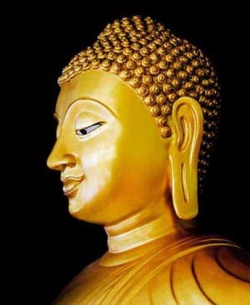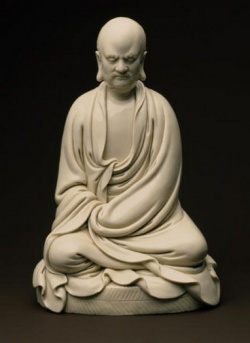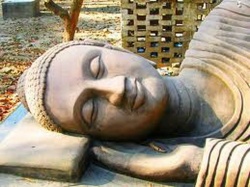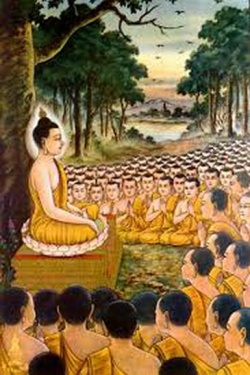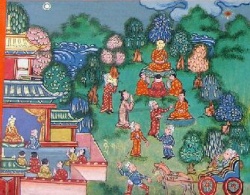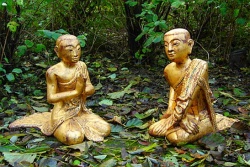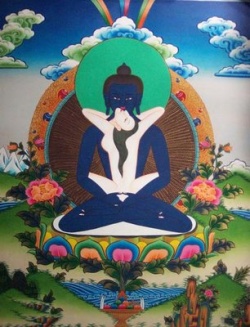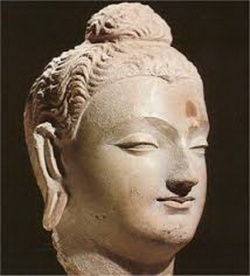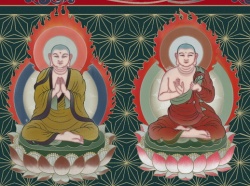Life between Life
A look at the Antarabhava in the Light of Vasubandhu
Consciousness has always been regarded within Buddhism as a continuity, a momentary series of Mental activities of various types which successively give rise to further activities of a similar nature and which continue in that pattern until altered by some external or internal factor.
Such activities (Skt: samskara) arise as a result of Mind/Body interactions which themselves produce the sensorial and psychological basis for Consciousness and which in turn modify, to some degree, all subsequent physical & Mental stimuli.
Consciousness is then seen as a stream of activities which continue ceaselessly and in accordance with the constituent factors and patterns making them up. It is imbued with the qualities these same factors have developed. Such patterns of activity fall into several different categories and are known within Buddhism as 'Skandha'.
This term, meaning 'a collection or 'heap' of processes' , describes the various and subjective Mental functions which are characterised by some common denominator usually based upon their particular Mental quality or object. In Buddhist teaching the Skandha stem from all the senses which arise from their respective organic bases plus their various 'Mental' senses of awareness and being. The collective action of the various Skandha actually forms what constitutes our ordinary concept of self awareness (mano Vijnana).
Though everyone has Skandha in common, human qualities and nature vary widely amongst different individuals, as each of the individual patterns and qualities constituting the Skandha depend upon the prior experiential factors of Mind or Body which have served to create, enforce or reinforce them. From the results of such patterns the different strengths or weaknesses of individual character or outlook are created.
If and when this pattern of continuity is altered in any way, the resultant Consciousness series which arises will manifest different patterns and qualities in order to accord with, and towards, those factors which have served to modify it. An alteration of the constituent bases serving to 'feed' Consciousness with its basic sensorial data is one such change and such a change occurs when we 'die'.
Vasubandhu's definition of Death can be seen by referring to his Pancaskhandaka Prakarana ("A Discussion Concerning the Five Skandha") [1], a work subsequent to his monumental and often quoted "Abhidharmakosha" writings, and in which he re-considered and modified many of the doctrinal and terminological definitions he outlined in the "Abhidharmakosha". In the "Pancaskhandaka" the definitions he gives for the 'Life force' and 'birth' can be combined to produce his view regarding the requisites for 'Life'.
In the "Pancaskhandaka" he defines such 'Life' to be :
"Any continuity in regard to the events taking place within an organism, which have been projected by past actions and which maintains a series of samskaras which have not arisen before.".
By means of this definition we can quite easily see how its converse (the Death state) would be defined, for it would be when
"Any continuity, in regard to events taking place within an organism and projected by past actions, does not arise."
In other words the continuity is broken or altered in some definite manner.
Vasubandhu's definition avoids many pitfalls and extremes, for instance it does not simply and exclusively posit 'Life' within either Mental or physical activities. Thus 'Death' to Vasubandhu cannot be represented only as a cessation of the Mental processes nor of the physical vitality. There were already within Buddhist teaching Life realms considered, in both 'this' World and others, which were characterized by the fact that their various inhabitants possessed neither Mental activity nor emotional activity and various shades in between these two states. The inhabitants of 'other worlds' naturally did not possess physical bodies.
We can see from such teachings that Buddhism exhibits a very different view from the usual with regard to what is considered 'dead' or 'alive' because it redefines just what these states actually consist of. Such differences come into sharp focus when we come to regard what occurs after Death.
The after-Death state has been the subject of much study and publicity in recent years, both in the popular media and literature. Accounts have been given of experiences which have arisen in hospital patients undergoing Life threatening operations [2]. and by those who recall transitions between and within previous existences. [2a] Despite the fact that many of these accounts may seem to be very new their findings have been foreshadowed and paralleled in the teachings of Buddhist Doctrine for over 2000 years.
As Buddhism teaches a Doctrine of Mental continuity (see the definition given above), the condition of Consciousness is not said to cease at either physical or Mental Death but to continue as before. Although it exhibits some differences in nature to that characterized in what we usually term the 'living', in Buddhist teaching such differences are not as great as we may assume. In Buddhism it is held that at the moment in the stream of manas Consciousness [3] following on immediately after physical 'Death' has taken place, manas continues its formative actions and pattern just as before. This pattern includes of course memories of all the Mind-Body interaction series and patterns from which it previously arose.
The after-Death manas retains this Form of continuity until it reaches a point at which the rupa (physically derived) Skandha series no longer has the Power to give rise to its self-renewing 'pulse'. If and when this occurs, manas is forced to undergo a change in the nature of its series, for it can no longer function or maintain the same Balance of factors it did before. It has to alter its state or kind of being.
To some it is at this point of change, i.e. in the basic pattern of the constituents of manas, that what is called 'Death' occurs in the sense of an irrevocable process. Those of this view hold that there must therefore exist an 'intermediary' state during which this final 'fading away' occurs and into which manas enters and continues before undergoing Rebirth into another realm.
However, others point out that Consciousness continually undergoes change at every moment of its existence as it continually accumulates and connects different experiences or Influences which serve to modify its Balance. To those holding this latter view, the concept of an intermediary state between existences is neither meaningful nor relevant, as in this view Rebirth occurs continually at each and every moment of Consciousness and thus, after Death will occur quite naturally. This is in fact the orthodox Theravada Doctrine of Sri Lankan, Thai and Burmese Buddhism. Coincidentally, it is within these nations that we find some of the most authenticated cases of both Rebirth and after Death experiences [See reference in Note 2.] The concept of intermediary existence is widely held in the Mahayana schools and is often used to explain the Phenomena of Ghosts etc.
Now we should ask ourselves, what kind of changes are possible in manas? To answer such a query we must turn to both the popular views and then to Vasubandhu's teachings concerning them. This is not always easy as he often presents and re-presents them in different manners, according to his audience.
Descriptions of the results of radical changes in the Consciousness series, such as may occur at the moment of Death or in the after-Life state are often presented from either a Moral or an experiential aspect.
In the first, change is presented as an alteration predominantly within the various subjective qualities of Consciousness. That is, with an emphasis upon its development and acquisition of virtues or vices, according to certain practices and understandings.
In the second, alterations are presented, somewhat anthropomorphically, as 'rebirths' of Consciousness into different places (such as heavens or hells). These two views should not be regarded as contradictory for each simply serves to illustrate different emphases.
In the popular Buddhist image Life itself manifests in six different forms. These six are often regarded simply as supernatural realms of reward or punishment for previous deeds (as is common in Christianity), but they equally may represent quite natural, but different, states of being within which Consciousness may re-manifest. They are all as 'real' as each other.
The six are popularly described and presented as consisting of the realms of Gods, Hells, Animals, Humans, Titans, and Ghosts. Each serves to portray a specific range of opportunities or possibilities open to Consciousness and summarizes the different results and responses to or from which we create the content of our Mental series.
Within the six there exist various sub-realms which are concerned with more specific characteristics or features of retributive existence. Thus there are said to be burning Hells, freezing Hells, Heavens of sensuality, of exalted Happiness, of shining beings etc. None of these conditions are regarded as permanent and thus the Suffering states resemble more the idea of a Purgatory or a 'testing ground' rather than a permanent place, even though they may seem very 'real' to those experiencing them. As in this present Life, it is always possible to transcend those states by recognizing and overcoming the causes which have brought us to them. Birth in the Human realm is regarded as the most beneficial as only here can one attain that Enlightenment which is the state beyond all the sufferings of change.
All such realms exist within one of the 'Three Spheres' of existence (triloka) of which the whole Universe is composed. These are known as the sphere of Desire (Kamaloka) the sphere of Form (rupaloka) and the Formless sphere (arupaloka).
In the kamaloka all the senses are readily available and are able to experience whatever they Desire in its full potential. The kamaloka includes all the lower realms along with certain realms of Gods. The World we now inhabit is part of this sphere.
In the rupaloka the actions of the senses of smell and taste are suspended. One only sees and hears here. This sphere is said to be able to be experienced through practice of the 4 Meditative absorptions (Jhana).
In the arupaloka all the physical sense bases and their associated responses are absent and only a Mental sense exists.
We should note that the latter two spheres describe higher states available to Consciousness within this lifetime through perfecting one's study and practice of the teaching.
An even simpler overall classification describes all such realms as being [1] those connected with the ebb and flow of the creation of Suffering, [2] those free of Suffering and [3] that of the Enlightened ones.
In his Vimsatikakarika ("Treatise in Twenty Verses") Vasubandhu questions the very existence of both the inhabitants and their torturers in the various Hell realms and by a series of arguments suggests that they are in fact creations manufactured from within the individual or collective manas of those experiencing them [4] Irrespective of what this appears to indicate, the Suffering experienced by persons 'in' these states is experienced in all its intensity. Vasubandhu also makes clear that persons may just as easily experience such Suffering states within the present Mental or physical lifetime.
He also shows that changes take place in only three ways, i.e. in potential, in location, or in state of being. It is in this latter Form that the changes we are considering occur, for Death is just that.
Vasubandhu teaches us that the purpose of understanding the Doctrine of change is to understand fully the causes of Suffering. He sees that this understanding is an essential part of liberating oneself from the often glamorous but unbeneficial Mental states (Akusala samskara) which in turn prompt the responses that lead us to increase our sufferings.
In the Karmasiddhiprakarana and later writings such as his Madhyantavibhaga ("Discerning the Middle from the Extremes") and Trisvabhavanirdesa ("Teaching of the Three Own Beings"), he speaks of another type of change in Consciousness, quite apart from the three discussed above, which comes about through truly recognising the dependent nature of Consciousness and the fictions it creates.
Vasubandhu explains this type of change as 'parinama', a complete transmutation of the Mental series as it evolves out of all its previous imperfections and constrictions to undergo a revolution at its basis ('asrayaparavritti') and from which the three ever present Mental 'stains' of Greed, Ignorance or hatred can no longer rise because their very basis has been totally dissolved. This exalted state forms part of the final Path leading to total Enlightenment.
The Path to this transmutation is achieved initially through developing the Bodhisattva orientation within systematic meditational practice, observation and analysis until it becomes possible for the practitioner to pierce through all the fictions to our perceptions of the states of being.
The Path to the clearing of the 'battlefield of the Consciousness' is an important prerequisite practice which enables the most effective type of result to occur. In order to know your enemy it is necessary to separate him from the camouflage.
One such enemy Vasubandhu also clearly sees is that of Language. He takes great pains to make clear what some of the old doctrinal terms really indicate and, if necessary, he replaces them with others of more subtlety and appropriateness. Eventually he points us towards a state beyond words and indeed all Language or communication whatsoever.
We can see that Vasubandhu's Yogacara method is teaching a highly dynamic and fully engaged Spiritual Path, and that he is not the abstract Intellectual 'clever clogs' he is often presented as being. Nor should his teaching be classified as either an 'idealism' [5] or a Doctrine of 'realistic pluralism' [6]. Nor did Vasubandhu ever teach that the World is 'Mind Only' [7]
In the past, many who have sought to understand his teaching have clung to the old meanings of many of the technical terms which occur in his writings and have often thereby obscured their intended significance.
Imbued with the Mahayana ideals to enable all beings to overcome Suffering, he works ceaselessly to explain the both the Doctrine and the experiences which come about through them in such clear manners that they become accessible to all who seriously attempt to understand them.
Acting as a skilful surgeon he is not afraid to cut away old concepts, introduces fresh ones and then, if needed, casts them away also, replacing them with others which have become strategically cogent as the internal situation progresses.
This method - of unending change and adaptation - has not often been realised by those who have previously presented his works to the general public, but once it is perceived, Vasubandhu's subtlety and genius become clear.
Nagaboshi Tomio
[1] This is in "7 Works of Vasubandhu". S.Anacker. Motilal Banarsidass. 1986. This is the latest and most accurate English Language translation of Vasubandhu's 7 later major texts and includes all the texts quoted here. An earlier translation of one of the texts included in the '7 Works' is the 'Karmasiddhi Prakarana' by E. Lamotte. (Eng.Trans. l.Pruden) Asian Humanities Press. 1988. Return
[2] See for instance:
"Adventures in Immortality". Gallup Jr. Souvenir Press.1982
"Encounters with the past". P.Moss & J.Keaton. Book Club Associates.1979 Return
[2a]
"Rebirth as Doctrine and Experience". F.Story. BAPS. Sri Lanka.1965
"20 cases suggestive of Reincarnation". Dr I.Stevenson. University of Virginia.1974 Return
[3] 'Manas' is the Sanskrit term used to describe the moment of Mental activity immediately preceding one, or a series, of Consciousness moments. It develops subsequently from any combination of the five physical senses and their associated Mental events and has the capacity of reflecting its own activities.
It is often used also to describe any type of Mental activity arising from or based upon a sense of 'self', as Manas forms the prerequisite activity for such a sense. In the later teachings of Vasubandhu it is said to take the 'Alaya' Consciousness as its main object. This term 'Alaya' is used to describe a deep lying and Constant psychological tendency to cling to both the notion of an unchanging permanent 'self' and to a belief in the reality of ones own Mental conceptual constructs.
It is composed of all the previous states and tendencies of an individual's Consciousness in a latent Form and as such contains all the potentialities and proclivities inherent to that individual, Such tendencies may be composed of complete sets of actions or activities ('seeds') or simply general overall inclinations. The Alaya continues as an underlying, undisturbed and unseen 'stream' of Consciousness and provides for the possibility of continuity within a Mental series.
Contrary to popular belief it is not a term peculiar to the Mahayana schools but can be found equally within the early scriptures such as Mahajima Nikaya 1:167. Vasubandhu's useage and definition of this term is quite different from that used in Mahayana Sutras such as the popular Lankavatara and is more in accord with the earlier Nikaya teaching.
Return
[4] We should bear in Mind that in Vasubandhu's teaching the experience of hallucinations is not 'imaginary' nor are Imaginations necessarily 'hallucinatory'. Such terms are only used in reference to the manner in which Phenomena manifest or appear to exist and the Mental relation we Form towards them. They do not impute any fixed status as to their 'reality' or 'unreality'.
Vasubandhu lived at a time when the Mahayana was still forming and as a convert from the Sautantrika school - the most philosophically developed of the earlier schools - he sought to reconcile the emergent Mahayana Doctrine and terminology to accord fully with the most ancient teachings. In the course of this he rejected, clarified or redefined many of the old Sautantrika, Vaibhasika and Mahisasaka sects definitions. The old theory of momentary being came under his special scrutiny and a reappraisal of this was one of the reasons he wrote the "Karmasiddhiprakarana". Return
[5] See: "The Yogacara Idealism". A.K.Chatterjee. M.l.B.D. Delhi.1986 Return
[6] "A Buddhist Doctrine of Experience". T.A.Kochmuttom. M.l.B.D. Delhi.1989. Return
[7] "Buddhist Thought in India" E.Conze. Pub.G.Allen & Unwin.1983. P:131 Although Conze mentions some of Vasubandhu's texts he seems not to have properly appreciated their meaning, nor have studied them fully. In this book Conze's view of Yogacara Thought seems to emerge from the later systems of Dignaga et al. rather than what Vasubandhu actually taught. Unusually (for Conze) he seems not to understand the teaching of Alayavijnana which he terms (p 133) a 'Conceptual monstrosity', and many of his queries or criticisms of it are in fact fully answered in the works of Vasubandhu whose content he quotes.
